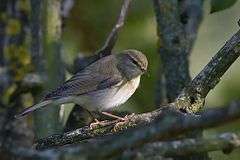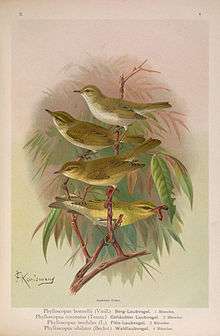Leaf warbler
Leaf warblers are small insectivorous passerine birds belonging to the genus Phylloscopus. The genus was introduced by the German zoologist Friedrich Boie in 1826.[1][2] The name Phylloscopus is from Ancient Greek phullon, "leaf", and skopos, "seeker" (from skopeo, "to watch").[3]
| Leaf warbler | |
|---|---|
 | |
| Western Bonelli's warbler (Phylloscopus bonelli) | |
| Scientific classification | |
| Kingdom: | Animalia |
| Phylum: | Chordata |
| Class: | Aves |
| Order: | Passeriformes |
| Superfamily: | Sylvioidea |
| Family: | Phylloscopidae Alström, Ericson, Olsson, & Sundberg, 2006 |
| Genus: | Phylloscopus F. Boie, 1826 |
| Species | |
|
More than 50 | |
Leaf warblers were formerly included in the Old World warbler family but are now considered to belong to the family Phylloscopidae, introduced in 2006.[4] The family originally included the genus Seicercus, but all species have been moved to Phylloscopus in the most recent classification. Leaf warblers are active, constantly moving, often flicking their wings as they glean the foliage for insects along the branches of trees and bushes. They forage at various levels within forests, from the top canopy to the understorey. Most of the species are markedly territorial both in their summer and winter quarters. Most are greenish or brownish above and off-white or yellowish below. Compared to some other "warblers", their songs are very simple. Species breeding in temperate regions are usually strongly migratory.

Description
The species are of various sizes, often green-plumaged above and yellow below, or more subdued with greyish-green to greyish-brown colours, varying little or not at all with the seasons. The tails are not very long and contain 12 feathers (unlike the similar Abroscopus species, which have 10 tail feathers). Many species are more easily identified by their distinctive songs than their dull plumage.[5]
Distribution and habitat
Its members occur in Eurasia, ranging into Wallacea and Africa with one species, the Arctic warbler, breeding as far east as Alaska). Many of the species breed at temperate and high latitudes in Eurasia and migrate substantial distances to winter in southeastern Asia, India, or Africa. One example is Tickell's leaf warbler, which breeds in scrub at high elevation in the Himalayas and on the Tibetan Plateau and then moves down-slope and south to winter in the Himalayan foothills of India and Burma.[6] Most live in forest and scrub and many are canopy or sub-canopy dwellers.
Behavior and ecology
The family Phylloscopidae comprises many small tree-loving warbler species and feed by gleaning insects from leaves or catching food on the wing.[6]
Taxonomy
The genus includes eleven species that were formerly placed in the genus Seicercus, but a 2018 molecular phylogeny study indicated that the genus Seicercus is a synonym of Phylloscopus, leaving the family Phylloscopidae with a single genus, Phylloscopus.[7]
The genus contains 81 species:[8]
- Wood warbler, Phylloscopus sibilatrix
- Western Bonelli's warbler, Phylloscopus bonelli
- Eastern Bonelli's warbler, Phylloscopus orientalis
- Buff-barred warbler, Phylloscopus pulcher
- Ashy-throated warbler, Phylloscopus maculipennis
- Hume's leaf warbler, Phylloscopus humei
- Yellow-browed warbler, Phylloscopus inornatus
- Brooks's leaf warbler, Phylloscopus subviridis
- Chinese leaf warbler, Phylloscopus yunnanensis
- Lemon-rumped warbler, Phylloscopus chloronotus
- Sichuan leaf warbler, Phylloscopus forresti
- Gansu leaf warbler, Phylloscopus kansuensis
- Pallas's leaf warbler, Phylloscopus proregulus
- Tytler's leaf warbler, Phylloscopus tytleri
- Yellow-streaked warbler, Phylloscopus armandii
- Radde's warbler, Phylloscopus schwarzi
- Sulphur-bellied warbler, Phylloscopus griseolus
- Tickell's leaf warbler, Phylloscopus affinis
- Alpine leaf warbler, Phylloscopus occisinensis
- Smoky warbler, Phylloscopus fuligiventer
- Dusky warbler, Phylloscopus fuscatus
- Plain leaf warbler, Phylloscopus neglectus
- Buff-throated warbler, Phylloscopus subaffinis
- Willow warbler, Phylloscopus trochilus
- Mountain chiffchaff, Phylloscopus sindianus
- Canary Islands chiffchaff, Phylloscopus canariensis
- Eastern Canary Islands chiffchaff, Phylloscopus canariensis exsul (extinct: 1986?)
- Western Canary Islands chiffchaff, Phylloscopus canariensis canariensis
- Common chiffchaff, Phylloscopus collybita
- Iberian chiffchaff, Phylloscopus brehmii
- Eastern crowned warbler, Phylloscopus coronatus
- Ijima's leaf warbler, Phylloscopus ijimae
- Philippine leaf warbler, Phylloscopus olivaceus
- Lemon-throated leaf warbler, Phylloscopus cebuensis
- Yellow-throated woodland warbler, Phylloscopus ruficapilla
- Brown woodland warbler, Phylloscopus umbrovirens
- Red-faced woodland warbler, Phylloscopus laetus
- Laura's woodland warbler, Phylloscopus laurae
- Black-capped woodland warbler, Phylloscopus herberti
- Uganda woodland warbler, Phylloscopus budongoensis
- White-spectacled warbler, Phylloscopus intermedius – (previously Seicercus affinis)
- Grey-cheeked warbler, Phylloscopus poliogenys – (previously placed in Seicercus)
- Green-crowned warbler, Phylloscopus burkii – (previously placed in Seicercus)
- Grey-crowned warbler, Phylloscopus tephrocephalus – (previously placed in Seicercus)
- Whistler's warbler, Phylloscopus whistleri – (previously placed in Seicercus)
- Bianchi's warbler, Phylloscopus valentini – (previously placed in Seicercus)
- Alström's warbler, Phylloscopus soror – (first described in 1999; previously placed in Seicercus)
- Martens's warbler, Phylloscopus omeiensis – (first described in 1999; previously placed in Seicercus)
- Green warbler, Phylloscopus nitidus
- Two-barred warbler, Phylloscopus plumbeitarsus
- Greenish warbler, Phylloscopus trochiloides
- Emei leaf warbler, Phylloscopus emeiensis
- Large-billed leaf warbler, Phylloscopus magnirostris
- Sakhalin leaf warbler, Phylloscopus borealoides
- Pale-legged leaf warbler, Phylloscopus tenellipes
- Japanese leaf warbler, Phylloscopus xanthodryas
- Kamchatka leaf warbler, Phylloscopus examinandus
- Arctic warbler, Phylloscopus borealis
- Chestnut-crowned warbler, Phylloscopus castaniceps – (previously placed in Seicercus)
- Sunda warbler, Phylloscopus grammiceps – (previously placed in Seicercus)
- Yellow-breasted warbler, Phylloscopus montis – (previously placed in Seicercus)
- Limestone leaf warbler, Phylloscopus calciatilis – (first described in 2010)
- Sulphur-breasted warbler, Phylloscopus ricketti
- Yellow-vented warbler, Phylloscopus cantator
- Western crowned warbler, Phylloscopus occipitalis
- Blyth's leaf warbler, Phylloscopus reguloides
- Claudia's leaf warbler, Phylloscopus claudiae
- Hartert's leaf warbler, Phylloscopus goodsoni
- Kloss's leaf warbler, Phylloscopus ogilviegranti – (formerly considered as a subspecies of Davison's leaf warbler)
- Hainan leaf warbler, Phylloscopus hainanus
- Davison's leaf warbler, Phylloscopus intensior – (previously white-tailed leaf warbler, Phylloscopus davisoni)
- Grey-hooded warbler, Phylloscopus xanthoschistos
- Mountain leaf warbler, Phylloscopus trivirgatus
- Negros leaf warbler, Phylloscopus nigrorum
- Timor leaf warbler, Phylloscopus presbytes
- Makira leaf warbler, Phylloscopus makirensis
- Sulawesi leaf warbler, Phylloscopus sarasinorum
- Kolombangara leaf warbler, Phylloscopus amoenus
- Island leaf warbler, Phylloscopus poliocephalus
- Numfor leaf warbler, Phylloscopus maforensis
- Biak leaf warbler, Phylloscopus misoriensis
- Rote leaf warbler, Phylloscopus rotiensis (first described in 2018)[9]
- Peleng leaf warbler, Phylloscopus suaramerdu
- Taliabu leaf warbler, Phylloscopus emilsalimi
References
- Mayr, Ernst; Cottrell, G. William, eds. (1986). Check-list of Birds of the World. Volume 11. Cambridge, Massachusetts: Museum of Comparative Zoology. p. 221.
- Boie, Friedrich (1826). "Generalübersicht der ornithologischen Ordnungen Familien und Gattugen". Isis von Oken (in German). 19. col. 972.
- Jobling, James A. (2010). The Helm Dictionary of Scientific Bird Names. London: Christopher Helm. p. 305. ISBN 978-1-4081-2501-4.
- Alström, P.; Ericson, P.G.P.; Olsson, U.; Sundberg, P. (2006). "Phylogeny and classification of the avian superfamily Sylvioidea". Molecular Phylogenetics and Evolution. 38 (2): 381–397. doi:10.1016/j.ympev.2005.05.015. PMID 16054402.
- Baker, Kevin (2010-06-30). Warblers of Europe, Asia and North Africa. A&C Black. p. 17. ISBN 9781408131701.
- "Lead-Warblers Phylloscopidae". creagrus.home.montereybay.com. 25 May 2006. Retrieved 2017-09-29.
- Alström, P.; et al. (2018). "Complete species-level phylogeny of the leaf warbler (Aves: Phylloscopidae) radiation". Molecular Phylogenetics and Evolution. 126: 141–152. doi:10.1016/j.ympev.2018.03.031. PMID 29631054.
- Gill, Frank; Donsker, David, eds. (2018). "Bushtits, leaf warblers, reed warblers". World Bird List Version 8.2. International Ornithologists' Union. Retrieved 8 August 2018.
- Ng, Nathaniel. S. R.; Prawiradilaga, Dewi. M.; Ng, Elize. Y. X.; Suparno; Ashari, Hidayat; Trainor, Colin; Verbelen, Philippe; Rheindt, Frank. E. (2018-10-23). "A striking new species of leaf warbler from the Lesser Sundas as uncovered through morphology and genomics". Scientific Reports. 8 (1): 15646. doi:10.1038/s41598-018-34101-7. ISSN 2045-2322. PMC 6199301. PMID 30353148.
Further reading
- Badyaev, Alexander V. & Leaf, Elizabeth S. (1997): "Habitat associations of song characteristics in Phylloscopus and Hippolais warblers". Auk 114(1): 40–46.
External links
| Wikimedia Commons has media related to Phylloscopus. |
- Leaf warbler videos on the Internet Bird Collection